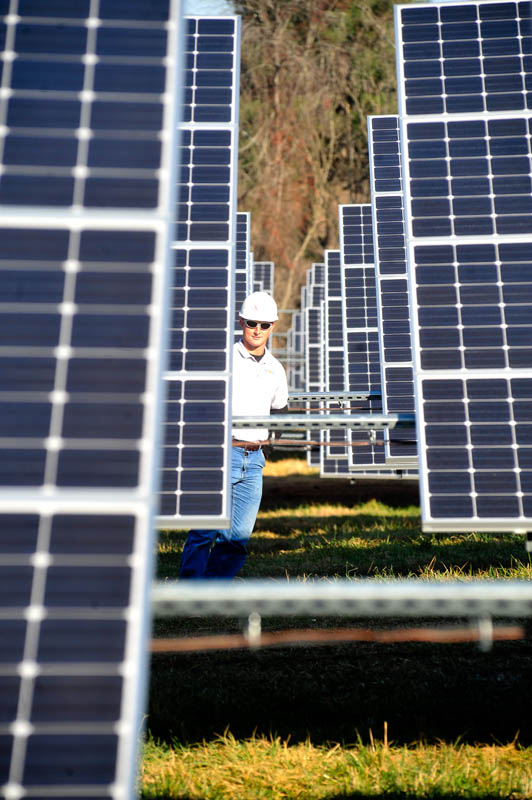
The sun will soon help power some operations at the Biltmore Estate: The company is preparing its new solar farm — a six-acre, 1.5 mega-Watt system of some 5,000 interconnected solar panels — for action next week. Among the largest of such installations in Western North Carolina, it can be glimpsed along Interstate 40 in Asheville. The final electrical inspection was set for Wednesday, Dec. 14, and project managers hope that the installation will be commissioned for operation the following week.
Why is Biltmore getting into solar power generation? According to Chuck Pickering, Biltmore’s vice president for Agriculture and Government Relations, give the credit to the early vision of George Vanderbilt, who aimed to develop a self-sustaining agricultural operation that emphasized stewardship of the land and its resources. Vanderbilt was interested in cutting-edge technology in every aspect, Pickering argues, from sustainable forestry to advanced agricultural practices to electric lights and laundry drying racks — and all back in the days when electrical power was new.
“We are looking at ways to really make a difference, both within our agricultural operations and our energy supply,” says Pickering. “This particular array is one of the most advanced systems,” he continues, explaining that it was built and engineered by Sun Energy1, a contractor out of Mooresville. “The system uses Bosch panels, chosen for their track record for performing in Europe, where cloudy days can impact solar performance. We finished our testing yesterday,” Pickering reports, “and they’re testing at 12 percent above norm. They’re running great.”
Pickering says the goal is for the entire Biltmore Estate to be net zero — that is, producing as least as much power as Estate operations need, plus excess power that is put back on the grid. “I would like to see that within five years, maybe faster,” he says. “It just depends on technology and the economics of it.”
The power generated by this array will service the buildings at Antler Hill Village, the Estate’s newest commercial development. Situated on about six acres, and visible on the south side of I-40 as it passes the Estate, the array consists of 19 rows of carefully calibrated racks, each holding twenty-eight 240-Watt solar panels, tilted to maximize solar uptake. The installation is laid out on a slight slope that allows the racks of panels to be placed as close together as possible without casting a shadow on the neighboring row.
This power project is just part of Biltmore’s larger sustainability efforts, Pickering points out. “We’ve been working hard for several years to put [green] things into practice,” he says, from the basic principles of reduce-reuse-recycle, to systematic plans for every department to reduce its carbon footprint. Estate staff and owners are now looking at the prospect of a solar thermal installation for the Biltmore Winery.
But they’re taking their time. “We do an extraordinary amount of due diligence on projects like this,” Pickering says.
photos by Bill Rhodes



What a great project! If only we (Americans) could have industries here in the US that make solar panels, and other alternative energy goods and services owned by Americans, and employing Americans.
Well, you can’t have everything (and in this case as well as other overwhelming examples, nothing at all).
Sad commentary on the state of manufacturing, and business and government leadership in this country. The alternative energy market could have been our next “Dot.Com” boom and pulled us out of this economic conundrum, but we missed the boat due to myopic thinking, and a greedy and corrupt business sector and local, state and federal government mindset. America V2.0: The new and improved
Has anyone gone through the house in cold weather? The money for this project would have been much better spent weatherizing the place. A huge expenditure spent mostly to impress the tourists.
6 Acres of rolling green hills with cattle roaming on top when viewed from I-40 have been replaced with 6 Acres of Black Solar Cells shading the green grass that will eventually erode. What’s so green about it?
The impact of long term coal fired power plants is much more environmentally unsound, this is the technology that solar is competing with. Mountain top removal is the newest strategy to locate and mine coal that provides us with cheap electricity. I suggest you read up on this, and the major health hazards associated with coal burning plants, and then perhaps the benefit of solar and perhaps wind power technology will become evident to not only the tourists, but you as well.